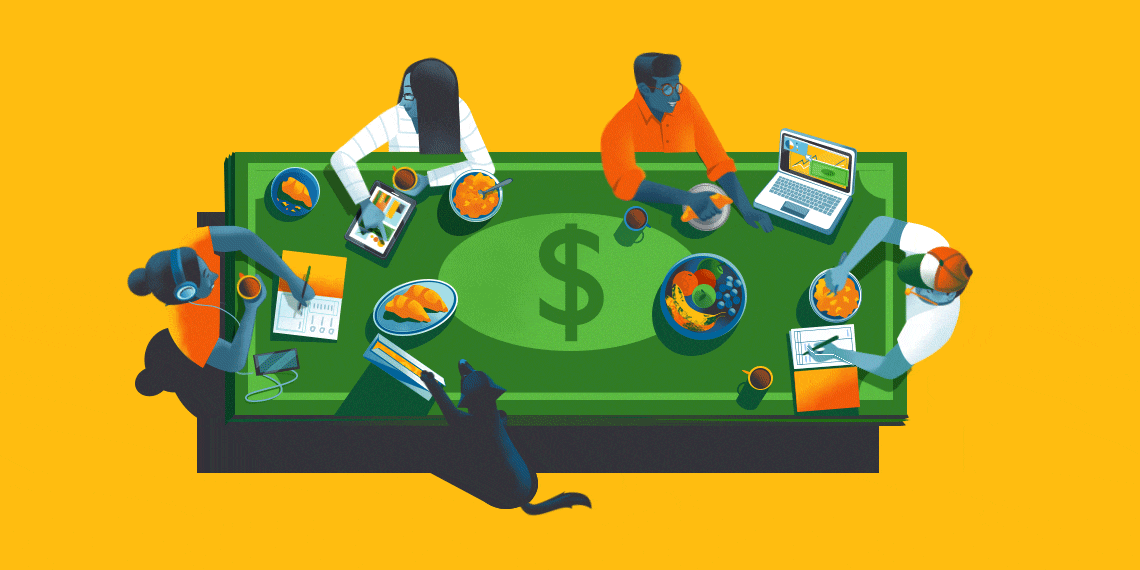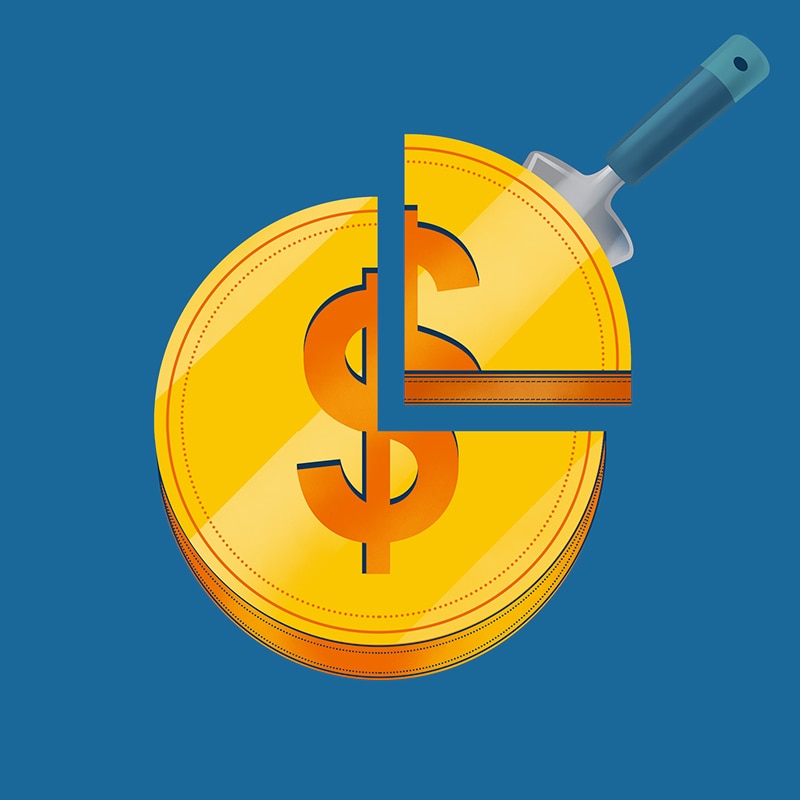
When is the best time to talk to your teenagers about financial literacy? If you answered “now,” congratulations—you’re correct!
In fact, there’s never a bad time to talk to your children about the ABCs of finances. Especially in this financially uncertain moment, you’ll be doing them a big favor by explaining the basics of how to be smarter with money.
Share the list below with your teenager so they can learn some essential financial lessons, either on their own or with your help. Here are 14 tips that will help them today and in the future.
1
How to Create a Budget
Starting a budget when you’re in high school is a great way to set yourself on a path to financial success. A budget is a financial tool that helps you assess your income (the money you earn from your job, allowance or any other source) and track your day-to-day spending.
Start that tracking over a 30-day period; the exercise will give you a sense of where your money is going. The most common expenses for teens are car payments, clothing, food and entertainment. Use a notebook to jot down every dollar you spend or do it digitally. You’ll find many easy ways to track your budget online, from basic online spreadsheets to smartphone apps like Mint and You Need a Budget.
The best part about a budget is that it allows you to see exactly where your money is going; this awareness will help focus your spending.
2
How to Be a Cautious Spender
This might sound obvious, but once you spend your money, it’s gone. Being careful about how you use your money can mean the difference between a happy and unhappy financial life.
Once you’ve identified how and where your money is going, you can eliminate unnecessary expenses. (You might be surprised how quickly those fast-food costs and in-app purchases add up!) Dialing back your food and entertainment budget can go a long way toward freeing up your funds for bigger purchases. Then, when it comes time to buy expensive items, like a car or a new phone, shop around for bargains and sales.
The money you don’t spend today is money you can hold onto for tomorrow, so thinking harder about every purchase will make a difference down the line.

3
How to Build Emergency Savings
When considering your budget, you want to do more than just break even. By spending carefully, you can start to stash away a set amount each month for your emergency savings. This is a dedicated pot of money that you should use only for emergencies—like if you lose your job or need to repair your car.
Financial experts suggest your emergency fund should cover three to six months of expenses. To build up this fund, do the math to see how much you can afford to set aside. Even if it’s only $20 a month, commit to saving that amount in case of emergency.
4
How to Open a Bank Account
Opening a bank account has never been easier. You no longer have to walk into a bank branch—you can just apply online. In most cases, you’ll only have to verify your identity by providing your birthday, address and Social Security number. If you’re under 18, you’ll likely need to add one of your parents’ names to the account.
The two main types of bank accounts are checking and savings. Your checking account is tied to your debit card—it’s what you want to use for day-to-day purchases. A savings account is for money that you don’t plan to touch as often, like when you’re saving for a car.
If you are considering opening an account with a new bank, remember to double-check that the bank is insured by the Federal Deposit Insurance Corporation, or FDIC. The FDIC is an agency that was created by Congress to protect up to $250,000 per depositor, per insured bank, for each ownership category. In-person banks usually have FDIC-insured plaques up in their branches; online banks will usually mention it on their webpage footers.
5
How to Earn Interest
The big difference between checking and savings? Savings accounts offer higher interest rates. Think of interest as the money the bank pays you for keeping your money with them. Different banks offer different rates, so shop around for a savings account, just as you would comparison shop for a car.
Interest rates also change over time. Basically, when banks want consumers to invest more money with them, they’ll raise the rates. That’s why it’s a smart money move to check rates every year or so and move your money to a different bank if you find a higher rate.
For example, if you have $5,000 in a checking account with a 1% interest rate, you’ll earn $50 in your first year. If another bank is offering a 2% interest rate, you can double that amount. Who wouldn’t want an extra $50?
Many banks charge fees if you don’t keep at least a certain balance in your account, or if you don’t make a certain number of deposits every month. Make sure you are saving in a no-fee bank (or meeting the requirements to avoid them), because those costs will eat into any returns you would see from interest.
6
How to Monitor Your Bank Account
In the days before mobile banking apps, people would keep a paper register for their checking accounts to keep track of their expenses. Now, of course, you don’t need to keep paper records, but that doesn’t mean you shouldn’t closely monitor your balance.
For starters, you should check your mobile banking app often—maybe even every day—to make sure there aren’t any fraudulent transactions. You typically have only 60 days to report these transactions to your bank; after that, you won’t be reimbursed. Another good reason to monitor your digital account is to keep on top of pending transactions, like direct deposits into your account.
7
How to Use Credit Wisely
Over half of all transactions in the United States are made by credit card, so you’re likely to use plastic at some point in your life. You’ll have to wait until you’re 18 to apply for a credit card, but long before that, you should understand what debt means for your long-term finances.
When the time comes for your own credit card, you need to make your monthly payments and plan to pay down debt in a reasonable period of time. Having too much credit card debt can lead to a lower credit score, which can make it difficult later on to get a loan for a car or home. (Read our comprehensive guide.)
8
How to Plan for the Cost of College
Student loans are another major line of credit that many Americans use. Surely, you’ve heard that college is expensive, but did you know that the average cost of attending a four-year public university is more than $21,000 a year? Tuition, books and room and board fees really add up.
When you graduate, you’ll have to repay your loans, so plan accordingly—it takes the average bachelor’s degree holder 21 years to do so. Also good to keep in mind: If you work in certain public-service jobs, such as teaching, the government will cancel your remaining balance after 10 years of payments. (That’s only for federal loans, though—you’ll still need to pay back any private loans you take out.)

9
How to Invest Money
Savings accounts aren’t the only way to earn money on your investments. Stocks (ownership stakes in companies that offer a variable rate of return) and bonds (a loan to a government or company that offers a fixed rate of return) are the two most common investment instruments.
It’s important to have a balanced portfolio—one that combines stocks and bonds to cushion the blow if the stock market takes a turn for the worse. The balance depends on how much risk you’re willing to accept. How do you figure that out? Consult a certified financial planner when you’re ready to invest.
10
How to Pay Taxes
Until you turn 18, you’re considered your parents’ dependent for tax purposes. However, if you earn more than $12,400 per year, you’ll have to file your taxes by Tax Day, which is usually April 15. Each year, you tally up what you owe based on what you earned in the previous calendar year. You’ll need to pay state and federal taxes, and in some cases, city or town taxes.
Even if you’re under the $12,400 threshold, the IRS will withhold income taxes from your paycheck. Remember that when you’re budgeting: Taxes mean that the amount you’re taking home will be less than the hourly rate you’re making.
11
How to Give Money to Charity
If you have the desire and the financial means to give back, research charitable organizations that you believe in. (As an additional incentive, philanthropy can also lower what you owe in taxes.) While you may not have the ability to donate today, start to think about causes you believe in and would like to support in the future.
12
How to Keep Your Information Safe
Identity theft can happen to anyone, and teens should be aware of how crucial it is to keep financial information secret. If a thief gets hold of your bank account or Social Security information, they could rack up purchases or even open a credit card in your name. Your birthdate, mother’s maiden name and other information are valuable to identity thieves, who can use them to crack your passwords. Even information that you don’t think is valuable—like posting vacation pictures on social media—can lead to theft, if someone knows you’re away from home. (Hint: Set your posts to “private.”)
13
How to Shop for Car Insurance
Car insurance prices differ greatly depending on which company writes your policy, so shopping around is essential. First, you’ll want to ask at least three insurers for quotes, which are estimated costs of coverage based on the make, model and age of your vehicle. Experts recommend reading the quotes closely; sometimes a higher price comes with better coverage that could make it worthwhile to spend a little more.
Come prepared to negotiate, as many insurers offer discounts for getting good grades or having an accident-free record. And plan to reassess your coverage every year or so. If your car is older, you might not need the most comprehensive (and often expensive) coverage.
14
How to Shop for Health Insurance
You can stay on your parents’ health plan until you’re 26. After that, you’ll want to be covered (and you also need to be, legally). Even if you’re young and healthy, the reality is that accidents happen.
Many employers offer private health insurance, so when you’re starting your career, ask questions about your company’s plan, including how much you’ll have to pay for doctor visits (copays) and how much you’ll have to spend out of pocket before the insurance coverage kicks in (the deductible). If you’re a freelance or gig worker, explore HealthCare.gov to review your options.
Here’s the bottom line: The best time to develop good financial habits is right now. You can still have fun and spend your money, but you’ll thank yourself (and your parents) later for making smart financial decisions today.
William Myers is a financial writer based in Dallas.
Art credit: Illustrations by Jack Hudson
Thinking of giving your teen their first credit card? Read our guide.

